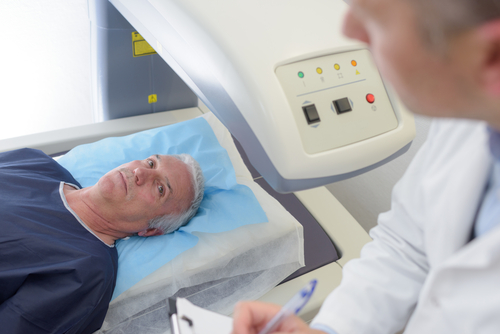Delivering radiation in a shorter time frame significantly reduced the chance of prostate cancer returning in men with an intermediate-risk form of the disease, a study found.
The approach failed to improve survival, however. Researchers argued that a survival benefit may occur only in a subset of patients in excellent health. They called for more research on the topic.
The study, “Conventional Versus Hypofractionated Radiation Therapy for Localized Prostate Cancer: A Meta-analysis of Randomized Noninferiority Trials,” was published in European Urology Focus.
Radiation therapy is an effective prostate cancer treatment. Standard radiation doses delivered daily over 40 to 45 treatment sessions reduce cancer recurrence and increase patients’ ability to survive without the cancer spreading. The standard treatment approach is called conformal radiation therapy, or CRT.
Benefits also accrue when doctors deliver higher doses of radiation over 15 to 30 sessions. This approach, called hypofractionated radiation therapy, or HRT, reduces patient cost and inconvenience.
But researchers didn’t know whether HRT was as effective as CRT. So a team at Brigham and Women’s Hospital decided to try to find out.
They analyzed data from three large clinical trials — RTOG 0415 (NCT00331773), CHHiP (NCT00392535) and PROFIT (NCT00304759).
The trials covered 5,485 prostate cancer patients, 3,553 or 65 percent of whom had an intermediate-risk form of cancer.
Researchers found that higher-dose radiation reduced the risk of cancer returning by 13 percent, compared with the standard-dose approach. And while the team saw a trend toward better overall survival in the men treated with high doses, the results did not reach statistical significance.
“Our results provide evidence for clinicians to consider HRT as compared with CRT as a preferred radiation treatment in men with intermediate-risk prostate cancer and at low risk of other complications,” Dr. Trevor Royce, a radiation oncologist at Brigham and Women’s Hospital, said in a press release.
“Treatment with a shorter course of radiation and higher doses over fewer days may be the preferred approach in appropriately selected patients with localized prostate cancer, reducing treatment time and cost to the patient, and increasing patient convenience and access to treatment,” added Royce, the study’s first author.
HRT-treated patients were at higher risk of side effects, however. They were 42 percent more likely to have acute gastrointestinal toxicity, and 18 percent more likely to have genital or urinary-organ complications.
“Late bladder and urethra toxicities were noted to be higher in the HRT as compared to CRT group, which necessitates carefully choosing men who are not at risk for sustaining a late bladder or urethral side effect,” said Dr, Anthony D’Amico, chief of Genitourinary Radiation Oncology at Brigham and Women’s Hospital. The urethra is a tube that drains urine from the bladder.
“Men to exclude would be those who get up more than three times at night to urinate, or have urgency to urinate, or incontinence, or men who are on anti-coagulants [anti-blood-clotting agents] that could increase the risk of bleeding,” said D’Amico, the senior author of the study.
Studies are needed to determine the benefits and potential toxicities of HRT as a treatment for high-risk prostate cancer, the team said.

